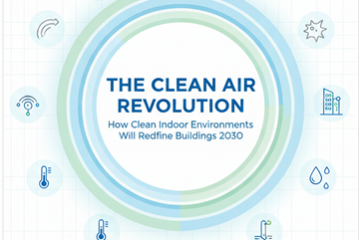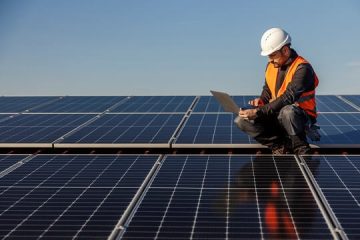FSPV design is similar to a conventional solar PV system except it requires a special arrangement to float on the water surface. The typical floating structure supports the PV arrays, inverters, combiner boxes, lighting arresters, etc. on a floating bed, which is made of fibre-reinforced plastic (FRP) or high-density polyethene (HDPE) or metal structures. The whole floating bed is buoyed with the help of anchoring and mooring systems.
PV Modules
The basic integral part of the FSPV plant is solar PV modules and like conventional solar projects generally, poly or monocrystalline or thin-film solar panels are used for the installation of the project. Selection of PV modules technology also defers because of space, cost, relative humidity, type of water-bodies, etc.
Inverter
Like a conventional solar plant, DC power generated from solar PV modules is taken to the inverter through a series of combiner boxes and finally converted into AC power. A developer may select multiple string inverters or central inverters. Depending upon scale and distance from shore, inverters can be placed either on a separate floating platform or on land. Generally, for smaller capacity FSPV inverter may be located on land near to PV arrays, otherwise for large.
Floating Platform
It supports all necessary components like solar PV during the project time. Hence selection of appropriate materials for the floating platform becomes imperative. HDPE (High-Density Polyethylene) is the most popular material being used in a majority of the FSPV power plants across the globe. Other materials like FRP, medium density polyethene (MDPE), and Ferro-cement are also been utilized as materials for the floating platform. Various designs of a floating platform are described below.
Pure-floats design
It uses a specially designed float that can hold PV panels directly. The entire system is made in a modular fashion and has a provision to join with pins or bolts to make a large platform. Every single unit of such a system typically consists of the main and secondary floats. The main purpose of the secondary float is to provide a walkway for maintenance and additional buoyancy. The design is being used by a few manufacturers, some of them are as follows:
Hydrelio from Ciel & Terre
The Ciel & Terre is a French technology provider, providing innovative floating solar solutions since 2011. In fact, it has the majority of market share in terms of total numbers of installations across 25.
countries, accounting for more than 300 MWp of installed capacity. Hydrelio floats are made of HDPE and connection pins are made of polypropylene combined with fibreglass. The floats are manufactured by blow moulding and pins are made from injection moulding.
<img width="605" height="354" src="http://dcsgroups.in/temp/wp-content/uploads/2020/09/Screen-Shot-2020-09-14-at-1.49.53-PM.png" alt="" srcset="https://i0.wp.com/www.firstgreen.co/wp-content/uploads/2020/09/Screen-Shot-2020-09-14-at-1.49.53-PM.png?w=605&ssl=1 605w, https://i0.wp.com/www.firstgreen.co/wp-content/uploads/2020/09/Screen-Shot-2020-09-14-at-1.49.53-PM.png?resize=302%2C177&ssl=1 302w, https://i0.wp.com/www.firstgreen.co/wp-content/uploads/2020/09/Screen-Shot-2020-09-14-at-1.49.53-PM.png?resize=150%2C88&ssl=1 150w" sizes="(max-width: 605px) 100vw, 605px" />
<p><strong>Sumitomo Mitsui Construction Co. Ltd.</strong>
The design is conceptually similar to Ciel & Terre, with some additional features like more regularly shaped float for denser packing and easy transportation. Additionally, a float is filled with polystyrene foam reducing the risk of sinking even when damaged and there is a usage of binding bands in the connecting part, which reduces the risk of structural failure for floats.
Yellow Tropus Pvt Ltd.
The Yellow Tropus is an India-based design and engineering company focused and specialized in the development of FSPV power plants. The company is offering three types of technology for land-neutral FSPV plants which are as follows:
1. Seahorse technology – One single unit of this consists of one walkway float and two solar PV panel float for supporting two solar PV panels.
2. Stingray Technology – It aims to minimize losses due to evaporation by covering more fraction of water surfaces. As per the company’s claims the technology is best suitable for large waterbodies that include thermal power plants, steel plants, chemical industries, water tanks that is manmade waterbodies with no aquatic life. One unit of this supports three solar PV panels and has two float sections namely South C-Hex float and North C-Hex float.



Pontoon + metal structures design
The other common design which is used by some project developers uses a metal structure similar to land-based system and pontoons to provide buoyancy, hence eliminating the need for specially designed floats. The main South C-Hex Float North C-Hex Float Solar PV Panel Use of resin as pontoon to oat Metal structure for solar PV panel mounting advantage of this type of design is, easier to make floats and hence can be manufactured locally. However, access for operation and maintenance is difficult in such designs.

Anchoring and Mooring System
Since FSPV plants are installed on water bodies, any variations in water levels induced by monsoon, wind velocity or increase/decrease in water quantity could be problematic for the plants. To avoid this situation, FSPV plants are anchored through mooring systems. The placement of a mooring system must take into account the location, bathymetry, soil conditions, and water-level variations. Mooring systems include quays, wharfs, jetties, piers, anchor buoys, and mooring buoys. Mooring system for a floating platform is generally attached with nylon polyester or nylon nautical ropes that are further tied to bollards on the bank and lashed at each corner. Mooring can be done in the following three ways – bank anchoring, bottom anchoring, and piles.
Bank anchoring – This type of anchoring is particularly suitable for sites, which are shallow, small and where the bottom of the water basin does not allow any kind of anchoring. Bank anchoring is the most cost-effective option and its suitability depends on the conditions of the shore. The main disadvantage of this type of mooring is its visibility from outside, impacting the landscape view.
Bottom anchoring – Due to its suitability and flexibility, this type of anchoring is more popular than other. This can be done in two ways – inserting anchors directly into the bottom of the waterbody and anchoring through concrete block placed at the bottom of the waterbody. The anchors are then connected to a floating platform with the help of mooring cable and chain. The cost of bottom anchoring is generally higher than other types as it requires careful planning while designing and involves divers.
Piles – In this, piles are drilled into the bottom of the waterbody and the floating platform then be moored to the piles. The main advantage of this type of configuration is in their capability to handle water level variations however, the need for heavy equipment and civil work makes it expensive.
Cabling
Cabling In case of FSPV plants, cable routing and its management requires cautious planning. Unlike ground-based solar PV installations, movement of the floating platform on a water surface causes cable length to vary in FSPV plants. The movement of the floating platform is due to wind load and variations in water level. This requires extra length in form of slack to be provided for accommodating the movement of the floating platform. Neglecting this, insufficient cable length may result in cables to snap and rupture due to the tension. Apart from the cable length, the other parameters upon which cable size depends are voltage and current of the cable and losses from the cable.
Source: Teri’s Report

